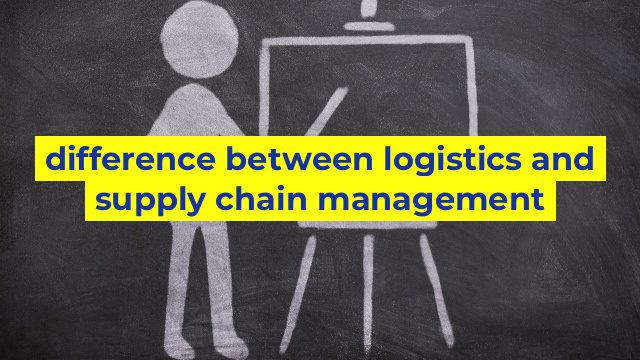The Difference Between Logistics and Supply Chain Management: Understanding the Key Definitions
As businesses continue to evolve, there is an increased need for effective supply chain management and logistics. However, many people use these terms interchangeably, when in fact they are two distinct concepts that play important roles in business operations. In this article, we will explore the key differences between logistics and supply chain management.
What is Logistics?
At its core, logistics refers to the process of planning, implementing, and controlling the movement of goods and services from one place to another. This includes transportation, storage, and distribution of products as they move along the supply chain. Logistics includes a wide range of functions, such as transportation management, inventory management, warehousing, and order fulfillment.
In short, logistics is a crucial factor in ensuring that products are transported efficiently and arrive at their intended destination in a timely manner.
What is Supply Chain Management?
Supply chain management (SCM) is a broader term that encompasses logistics, but extends beyond just the movement of products. It includes everything from sourcing raw materials to delivering finished goods to the end customer. SCM also involves managing relationships with suppliers, manufacturers, distributors, and retailers to ensure a smooth flow of goods and services along the supply chain.
SCM helps businesses optimize their entire supply chain, from procurement to distribution. It involves planning, procurement, manufacturing, transportation, warehousing, and customer service. The overarching goal of SCM is to improve the efficiency and effectiveness of the supply chain and maximize customer value.
The Key Differences Between Logistics and Supply Chain Management
While logistics and supply chain management share some similarities, there are some important differences to keep in mind. Here are a few key distinctions:
– Logistics is a subset of supply chain management. It involves the physical movement of goods and services, whereas SCM covers the full spectrum of activities involved in bringing a product to market.
– Logistics focuses on specific activities within the supply chain, such as transportation, warehousing, and order fulfillment. Whereas, SCM covers the entire process, from procurement to distribution.
– Logistics is a more tactical function, whereas SCM is a more strategic function.
– Logistics deals with tangible goods, while SCM can also include intangible services as well.
Conclusion
In conclusion, both logistics and supply chain management are critical elements of a successful business operation, and it’s important to understand the distinctions between them. While logistics plays an important role in moving goods, supply chain management takes a more strategic view of the entire process, from procurement to delivery. By understanding these concepts, businesses can maximize their efficiency and improve their bottom line.
Table difference between logistics and supply chain management
| Point of Difference | Logistics | Supply Chain Management |
|---|---|---|
| Definition | The process of planning, implementing, and controlling the flow of goods and services from the point of origin to the point of consumption. | The coordination and management of the entire network of organizations, activities, and resources involved in the creation and delivery of a product or service. |
| Focus | Focuses on the physical movement and storage of goods. | Focuses on the complete chain of activities from raw materials to end users. |
| Scope | Limited to transportation, warehousing, and distribution tasks. | Involves procurement, production, inventory management, warehousing, distribution, and customer service. |
| Goal | Goal is to ensure that materials and products flow through the supply chain efficiently and effectively. | Goal is to create a competitive advantage by reducing costs, increasing efficiency, and improving customer satisfaction. |
| Approach | Focuses on optimization of individual functions within the supply chain. | Looks at the entire supply chain as a system and optimizes it for maximum efficiency and effectiveness. |
| Collaboration | Collaboration with partners is limited to transportation and warehousing activities. | Collaboration with partners is essential for success and involves active communication, coordination, and cooperation. |

